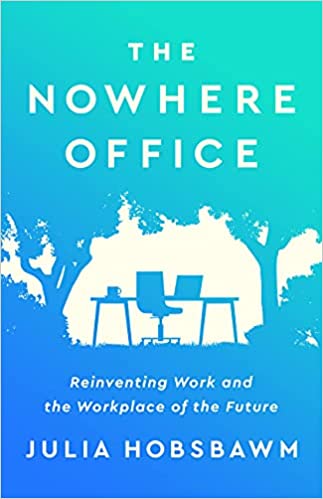
The Hybrid Campus and ‘The Nowhere Office’
Author: Joshua Kim
Source
 The Nowhere Office: Reinventing Work and the Workplace of the Future by Julia Hobsbawm
The Nowhere Office: Reinventing Work and the Workplace of the Future by Julia Hobsbawm
Published in April of 2022.
The post-pandemic university has gone hybrid.
The new default for residential teaching and learning is at least blended, and maybe hyflex. Online education has permanently moved from the margins to the center.
Less talked about but hugely consequential for academic culture is the reality that staff now behave more like faculty. Where professors have always worked in a hybrid manner, non-faculty academic professionals now routinely combine on-campus and at-home work.
As higher education shifts to the new normal of endemic Covid, we must rethink the campus. The Nowhere Office is an excellent book to catalyze a conversation about the hybrid campus.
In the book, author and consultant Julia Hobsbawm (daughter of the immensely influential late historian Eric Hobsbawm) contextualizes post-pandemic professional working life within the larger story of changes in office culture. The Nowhere Office represents an acceleration of long-running trends in which the highest-status workers were already mobile, flexible, and autonomous.
Post-Covid, this flexibility to do professional keyboard/meeting-based work from either home or office has been extended to a much broader range of employees. Corporate knowledge workers are no longer willing to endure long commutes and distracting office environments to merely signal a commitment to the job. Instead, they make decisions about where they do their work based on what work environment is productivity optimal.
For companies, this means that offices are evolving into places where professionals gather for communication, learning, and creative collaboration. Heads-down thinking, producing, and ongoing collaboration tasks can occur effectively from home and on digital platforms. In-person and in-office time is best spent doing what is difficult to accomplish by e-mail and Zoom.
This evolution of office culture and design is, for Hobsbawm, a welcome change. She writes that the rise of the Nowhere Office represents an opportunity to rethink the design of professional work. Hobsbawm notes that worker well-being has long been an afterthought, a goal pushed off to under-resourced HR departments and poorly operationalized through superficial corporate wellness programs. In designing the new hybrid work arrangements, companies can evolve the culture of employment in more flexible and humane ways.
What will our campuses be like going forward?
A college campus is many things. The list is too long to enumerate all the activities that our campuses encompass. One of those activities is that campuses are workplaces.
What does the campus as a place of work feel like when that work has moved from primarily residential to hybrid?
How is the culture of our institutions changed when the default for meetings — and academic staff work runs on meetings — is Zoom?
What is the price we pay in institutional community building for the genuine benefits we gain from greater working flexibility?
How might the expanding range of colleagues who work primarily or exclusively remotely be integrated into the fabric of academic life?
For those of us who do professional work for residential universities, what are the tasks that are done best when physically working on campus?
Can we imagine a different design than open offices for the spaces in which professional academic staff work when on campus?
The Nowhere Office provides a range of ideas that forward-thinking companies are adopting in their quest to recruit and retain talent. While many of the lessons from the corporate world will not be applicable or appropriate for higher education, some might be.
Above all, The Nowhere Office argues that the post-Covid workplace must be designed with intention. That to bring workers back to the office, a goal that many CEOs have articulated, that the office of the future can’t look like what we left behind in March of 2020.
If we think the presence of academic staff adds to the vibrancy and quality of campus life, we need to consider what staff requires to feel their work is best done from campus. And for those whose jobs are now primarily hybrid or remote-first, we need to figure out how to incorporate these colleagues into the dense web of interactions and exchanges that constitute academic life.
What are you reading?
